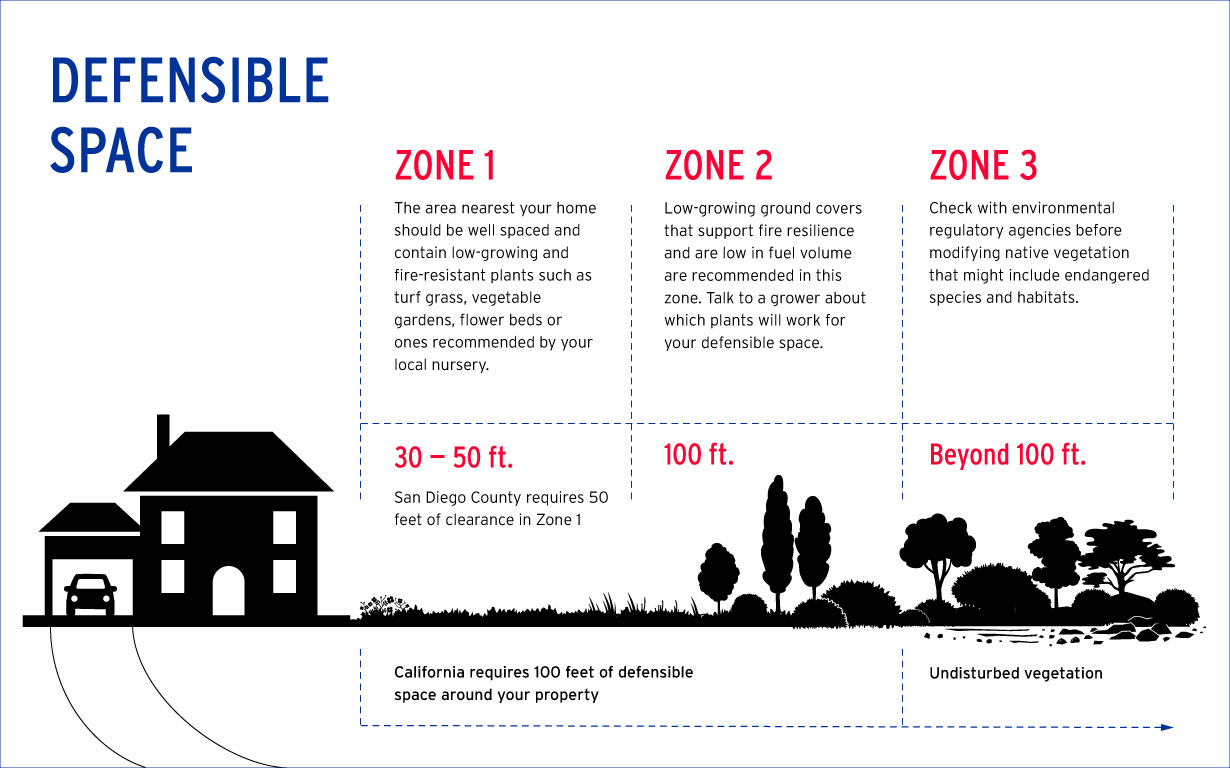Creating a Fire-Safe Landscape in San Diego County: A Comprehensive Guide
San Diego County’s stunning landscapes come with the challenge of wildfire risk, especially as the fire season approaches. With the right strategies and proactive measures, you can significantly enhance the safety of your property and contribute to the broader community’s fire resilience. This guide will delve into comprehensive fire-safe landscaping strategies tailored for San Diego’s unique climate and conditions.
Understanding the Importance of Defensible Space
Creating a defensible space around your home is the cornerstone of wildfire prevention. This buffer zone is designed to minimize the potential for fire to spread to your home and provide firefighters with a safer environment to protect your property. Defensible space is divided into different zones, each with specific requirements and recommendations:

Zone 1: 0-30 Feet from Your Home
- Reduce Flammable Vegetation: The area closest to your home should be kept free of highly flammable vegetation. Regularly trim or remove shrubs, trees, and other plants that are close to your home to prevent a fire from easily reaching the structure.
- Maintain a Green Zone: Keep lawns and garden areas well-watered and maintained. Green, healthy plants are less likely to ignite than dry, overgrown ones.
- Fire-Resistant Plants: Use plants that are less likely to catch fire. Opt for species like succulents, ground covers, and low-growing shrubs that have high moisture content and low resin levels.
- Clear Debris: Regularly remove leaves, twigs, and other debris from your roof, gutters, and around your home. These materials can easily ignite and contribute to the spread of fire.
Zone 2: 30-100 Feet from Your Home
- Create Fuel Breaks: Incorporate non-flammable materials such as gravel, stone, or paved paths to break up large areas of vegetation. Fuel breaks can help slow down the progress of a fire and protect your home.
- Spacing Between Plants: Ensure there is adequate spacing between trees and shrubs to prevent the spread of fire from one plant to another. Avoid creating dense clusters of vegetation.
- Prune Trees: Keep the lowest branches of trees at least 6-10 feet off the ground to prevent a fire from climbing into the tree canopy. Remove dead or dying branches that can easily catch fire.
- Use Hardscaping: Incorporate hardscaping elements like patios, walkways, and retaining walls into your landscape design. These non-flammable surfaces can act as firebreaks.
Choosing Fire-Resistant Plants
Selecting the right plants is crucial in creating a fire-safe landscape. Fire-resistant plants are those that are less likely to ignite and contribute to the spread of fire. When choosing plants for your San Diego landscape, consider the following characteristics:
- High Moisture Content: Plants with high water content, such as succulents and ferns, are less likely to catch fire. They provide a natural barrier to flames and help maintain a green, healthy landscape.
- Low Resin and Oil Content: Avoid plants with high resin or oil content, such as junipers and eucalyptus. These plants are highly flammable and can easily catch fire.
- Slow-Growing Species: Opt for plants that grow slowly and produce less fuel for fires. Fast-growing plants may quickly become a fire hazard if not properly maintained.
Recommended Fire-Resistant Plants for San Diego:
- Aloe Vera: This succulent is not only fire-resistant but also adds a striking architectural element to your garden. Aloe Vera’s thick, fleshy leaves retain moisture and are less likely to ignite.
- California Lilac (Ceanothus): A native shrub that provides beautiful blue or purple flowers while being resistant to fire. It’s well-suited to San Diego’s climate and requires minimal maintenance.
- Manzanita: Known for its smooth, reddish bark and attractive, evergreen leaves, Manzanita is an excellent fire-resistant plant that adds visual interest to your landscape.
Maintaining Your Landscape for Fire Safety
Even with a well-planned fire-safe landscape, regular maintenance is crucial to ensure ongoing fire protection. Here are some maintenance tips to keep your landscape in top shape:
- Seasonal Pruning: Regularly prune trees and shrubs, especially before and during fire season. Remove dead or dying plants and branches that can become fuel for fires.
- Irrigation Systems: Keep your landscape hydrated with efficient irrigation systems. Drip irrigation is ideal for delivering water directly to plant roots without wasting water. Ensure your irrigation system is functioning properly and adjust it according to seasonal changes.
- Weed Control: Remove invasive weeds and grasses that can dry out and become highly flammable. Mulching can help suppress weed growth and retain soil moisture. However, avoid using flammable mulches like wood chips close to your home.
- Regular Inspections: Conduct regular inspections of your landscape to identify potential fire hazards. Look for areas where vegetation might be too dense or where dead plant material has accumulated.
Incorporating Hardscaping and Structural Measures
In addition to plant selection and maintenance, the materials and design of your landscape play a crucial role in fire safety. Consider the following hardscaping and structural measures:
- Non-Flammable Fencing: Use metal or masonry for fencing near your home to prevent the spread of flames. Wooden fences can act as a wick for fire and should be avoided or placed far from the house.
- Driveways and Walkways: Design driveways and walkways with non-flammable materials such as concrete, stone, or gravel. These surfaces can serve as effective firebreaks and provide access for emergency services.
- Fire Pits and BBQ Areas: Ensure that fire pits and BBQ areas are clear of flammable vegetation and materials. Always have a water source or fire extinguisher nearby when using these areas, and follow local fire regulations and guidelines.
Community Involvement and Preparedness
Creating a fire-safe landscape is not only about protecting your property but also about contributing to the safety of your entire community. Here are ways to engage with your neighbors and stay prepared:
- Collaborate with Neighbors: Encourage your neighbors to create their own defensible spaces and adopt fire-safe landscaping practices. A collective effort can greatly reduce the risk of wildfire spreading through your neighborhood.
- Community Firewise Programs: Participate in local Firewise programs and initiatives. These programs provide valuable resources and support for communities to enhance their fire resilience.
- Stay Informed: Keep up to date with local fire conditions and alerts. Sign up for emergency notifications and stay informed about fire safety recommendations and evacuation procedures.
Additional Resources and Tools
To further assist in creating a fire-safe landscape, consider utilizing the following resources and tools:
- Fire-Resistant Plant Lists: Refer to local fire department or gardening websites for updated lists of fire-resistant plants suitable for San Diego’s climate.
- Irrigation Guides: Explore resources on efficient irrigation practices and systems designed for fire-safe landscaping.
- Fire Safety Apps: Use mobile apps that provide real-time fire alerts, evacuation routes, and safety tips.
Conclusion
In San Diego County, where the risk of wildfires is ever-present, creating a fire-safe landscape is a critical step in protecting your home and community. By understanding the principles of defensible space, choosing fire-resistant plants, maintaining your landscape, and incorporating hardscaping measures, you can significantly reduce the risk of wildfire damage. Engage with your neighbors and stay informed to contribute to a safer environment for everyone. With thoughtful planning and proactive measures, you can enjoy the beauty of your landscape with the confidence that you’re prepared for the challenges of fire season. For more information on wildfire preparedness, click here.
lastly if you have any questions and would like to know how to make your property fire-safe, feel free to contact us!



